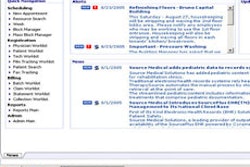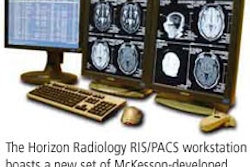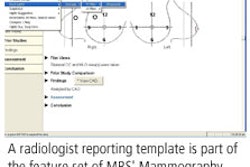LAS VEGAS - First-year medical students who choose radiology as a specialty will face demanding workloads during their first year of private practice. According to Dr. Eliot Siegel, a newly minted radiologist in 2015 will be responsible for reviewing more than 600,000 images in a single day, broken out as 50 studies with three window/level settings comprising 2,000 images each, plus a comparison study.
"The tools available to radiologists today will not meet the demands and increased expectations of radiology practice in 2015," he said.
Siegel, professor and vice chairman of diagnostic radiology at the University of Maryland School of Medicine in Baltimore and chief of imaging at the Veterans Affairs Maryland Healthcare System, offered a perspective on the capability of informatics to address radiology's needs now and in the future during a plenary session on Monday at the American Healthcare Radiology Administrators (AHRA) annual meeting.
"The vision for the future of radiology will be heavily influenced by the field of medical imaging informatics," Siegel said.
He believes vendors, radiology subspecialty societies, and information technology professionals all will play a role in developing the next generation of radiology informatics tools and applications. However, the combination of medical informatics and imaging information theory will be the strongest influencer in this effort due to its substantial clinical knowledge and grounding in digital technologies.
Although the challenge of a 600,000-image workday seems almost unreal, current demands on radiologists place them at more than 80,000 CT images for interpretation on a daily basis, according to studies done by Dr. Rick Morin at the Mayo Clinic in Jacksonville, FL.
But, radiology administrators can take steps now to mitigate image interpretation overload and help prepare their practice to address the challenges of the near future, Siegel said.
He noted that many radiology departments generally have a rather haphazard workflow analysis and that few tools are available for workflow improvement.
"Analyzing and improving workflow and productivity is an interesting imaging informatics challenge today especially given the potential impact of the Deficit Reduction Act of 2005," Siegel said.
For example, in 1989 his then film-based radiology department conducted a workflow analysis and found that there were 59 discrete steps from the referring physician order for diagnostic imaging services until the report on the exam was returned to the referring physician. Since that time, PACS, RIS, and speech recognition (SR) technologies have been deployed in the department. According to Siegel, there are now eight discrete steps to the exam process.
One of the tools he recommended considering for workflow analysis is simulation modeling. These software applications allow the creation of a radiology practice environment and permit a user to introduce new variables into that space, such as a higher patient volume. Once the application is run, it allows the user to examine the impact of new variables on the practice.
Although often not considered as part of a technical workflow analysis, workstation optimization is an element that administrators should address. Whether it is the radiologist reading room, technologist workstation, or clerical workspace, creating an ergonomically correct and efficient environment will result in higher productivity, better morale, and lower personnel turnover.
Interoperability with other medical systems within a healthcare enterprise is an important element of workflow optimization, Siegel said.
"PACS must itself not be an island, but must communicate with other hospital information systems," he said.
Siegel recommended that all systems within the radiology department adhere to the Integrating the Healthcare Enterprise (IHE) profiles. These profiles allow the interchange of information from disparate medical systems through common standards such as DICOM or HL7.
The radiology report is the critical communication element of the specialty and has changed little in the past 110 years, Siegel said. In a 2005 study, he and his colleagues reported that their research indicated that the number of concepts (other than normal) for chest radiography was relatively small, but that the report length varied depending on the radiologist.
Structured reporting is a tool that if properly designed and implemented holds great promise for improving efficiency and referring physician satisfaction, and allowing cross-correlation of imaging with other patient data in electronic medical record (EMR) reports. This can be done using a speech or an interactive report generating tool, he said, or retrospectively by natural language processing (NLP) of a free-text report into a structured one.
With the exception of BI-RADS, there has been very little adoption of structured reporting in the radiology community, primarily due to lack of an imaging lexicon, according to Siegel. This may change in the near future as the RSNA's RadLex project begins bringing its work, such as its thoracic lexicon, to the radiology community.
Siegel also acknowledged the recent introduction of tools to close the communication loop between the referring and interpreting physician. Ideally, these applications communicate findings, record acknowledgement of receipt of information, then follow-up on recommendations, he said.
A great deal of improvement will need to occur to get to the point where the needs of the next generation of radiologists and those of a more sophisticated and demanding world of medicine can be supported.
"The field of imaging informatics holds the key to this diagnostic imaging practice of the future," he said. "The training of our current crop of residents and fellows, as well as the entire radiology community, will be essential if we are to move forward as rapidly as we will need to in order to get to where we will need to be in 2015."
By Jonathan S. Batchelor
AuntMinnie.com staff writer
August 1, 2006
Related Reading
Improve what? Finding a process to improve, July 27, 2006
IHE's Import Reconciliation Workflow eases portable media handling, July 17, 2006
Poor workflow can hinder use of 3D software, June 30, 2006
Strategic planning considerations and the Deficit Reduction Act of 2005, June 27, 2006
Work-site assessments reduce risk exposure and improve productivity, May 17, 2006
Copyright © 2006 AuntMinnie.com



















